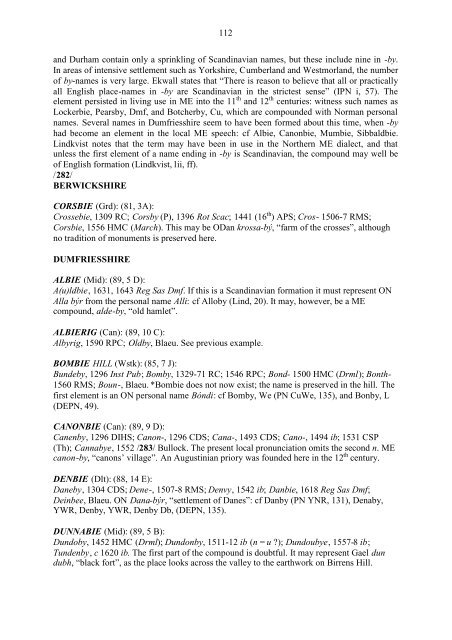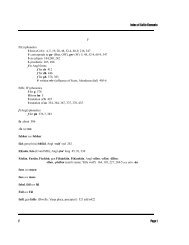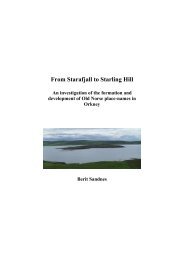May Williamson: The Non-Celtic Place-Names of the Scottish Border ...
May Williamson: The Non-Celtic Place-Names of the Scottish Border ...
May Williamson: The Non-Celtic Place-Names of the Scottish Border ...
Create successful ePaper yourself
Turn your PDF publications into a flip-book with our unique Google optimized e-Paper software.
112<br />
and Durham contain only a sprinkling <strong>of</strong> Scandinavian names, but <strong>the</strong>se include nine in -by.<br />
In areas <strong>of</strong> intensive settlement such as Yorkshire, Cumberland and Westmorland, <strong>the</strong> number<br />
<strong>of</strong> by-names is very large. Ekwall states that “<strong>The</strong>re is reason to believe that all or practically<br />
all English place-names in -by are Scandinavian in <strong>the</strong> strictest sense” (IPN i, 57). <strong>The</strong><br />
element persisted in living use in ME into <strong>the</strong> 11 th and 12 th centuries: witness such names as<br />
Lockerbie, Pearsby, Dmf, and Botcherby, Cu, which are compounded with Norman personal<br />
names. Several names in Dumfriesshire seem to have been formed about this time, when -by<br />
had become an element in <strong>the</strong> local ME speech: cf Albie, Canonbie, Mumbie, Sibbaldbie.<br />
Lindkvist notes that <strong>the</strong> term may have been in use in <strong>the</strong> Nor<strong>the</strong>rn ME dialect, and that<br />
unless <strong>the</strong> first element <strong>of</strong> a name ending in -by is Scandinavian, <strong>the</strong> compound may well be<br />
<strong>of</strong> English formation (Lindkvist, lii, ff).<br />
/282/<br />
BERWICKSHIRE<br />
CORSBIE (Grd): (81, 3A):<br />
Crossebie, 1309 RC; Corsby (P), 1396 Rot Scac; 1441 (16 th ) APS; Cros- 1506-7 RMS;<br />
Corsbie, 1556 HMC (March). This may be ODan krossa-bý, “farm <strong>of</strong> <strong>the</strong> crosses”, although<br />
no tradition <strong>of</strong> monuments is preserved here.<br />
DUMFRIESSHIRE<br />
ALBIE (Mid): (89, 5 D):<br />
A(u)ldbie, 1631, 1643 Reg Sas Dmf. If this is a Scandinavian formation it must represent ON<br />
Alla býr from <strong>the</strong> personal name Alli: cf Alloby (Lind, 20). It may, however, be a ME<br />
compound, alde-by, “old hamlet”.<br />
ALBIERIG (Can): (89, 10 C):<br />
Albyrig, 1590 RPC; Oldby, Blaeu. See previous example.<br />
BOMBIE HILL (Wstk): (85, 7 J):<br />
Bundeby, 1296 Inst Pub; Bomby, 1329-71 RC; 1546 RPC; Bond- 1500 HMC (Drml); Bonth-<br />
1560 RMS; Boun-, Blaeu. *Bombie does not now exist; <strong>the</strong> name is preserved in <strong>the</strong> hill. <strong>The</strong><br />
first element is an ON personal name Bóndi: cf Bomby, We (PN CuWe, 135), and Bonby, L<br />
(DEPN, 49).<br />
CANONBIE (Can): (89, 9 D):<br />
Canenby, 1296 DIHS; Canon-, 1296 CDS; Cana-, 1493 CDS; Cano-, 1494 ib; 1531 CSP<br />
(Th); Cannabye, 1552 /283/ Bullock. <strong>The</strong> present local pronunciation omits <strong>the</strong> second n. ME<br />
canon-by, “canons’ village”. An Augustinian priory was founded here in <strong>the</strong> 12 th century.<br />
DENBIE (Dlt): (88, 14 E):<br />
Daneby, 1304 CDS; Dene-, 1507-8 RMS; Denvy, 1542 ib; Danbie, 1618 Reg Sas Dmf;<br />
Deinbee, Blaeu. ON Dana-býr, “settlement <strong>of</strong> Danes”: cf Danby (PN YNR, 131), Denaby,<br />
YWR, Denby, YWR, Denby Db, (DEPN, 135).<br />
DUNNABIE (Mid): (89, 5 B):<br />
Dundoby, 1452 HMC (Drml); Dundonby, 1511-12 ib (n = u ); Dundoubye, 1557-8 ib;<br />
Tundenby, c 1620 ib. <strong>The</strong> first part <strong>of</strong> <strong>the</strong> compound is doubtful. It may represent Gael dun<br />
dubh, “black fort”, as <strong>the</strong> place looks across <strong>the</strong> valley to <strong>the</strong> earthwork on Birrens Hill.




